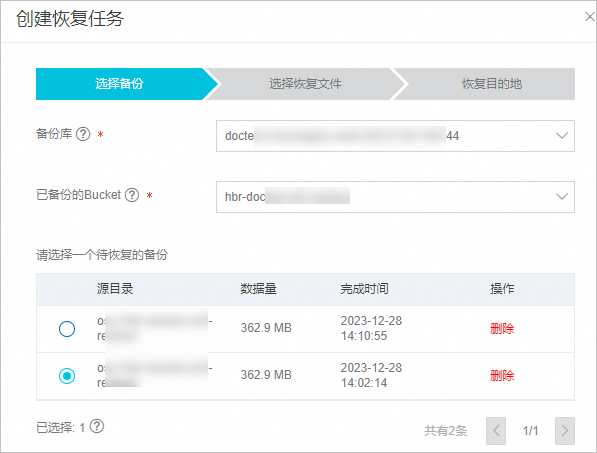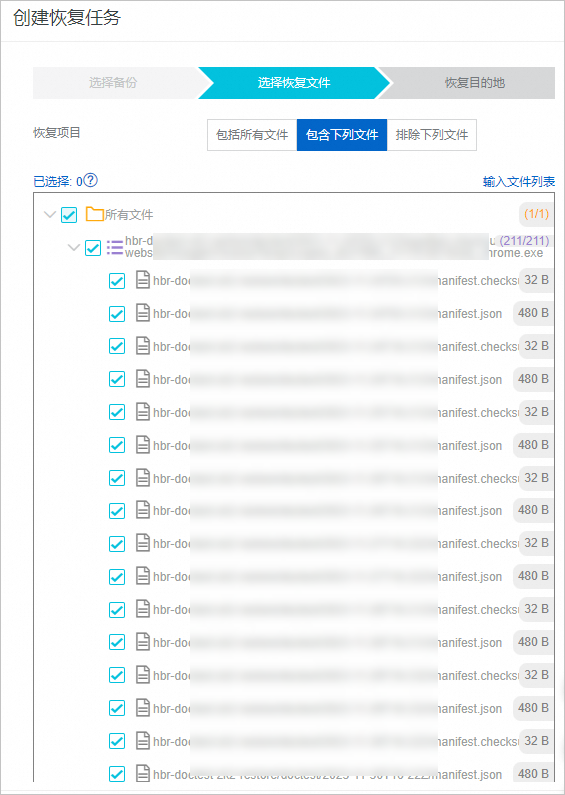使用Cloud Backup將OSS備份到雲上備份庫後,OSS中檔案丟失或者受損時,您可以根據歷史備份,將全量檔案或者滿足條件的部分檔案進行恢複,可以免費恢複至源OSS或者免費恢複至一個新的OSS。
前提條件
已建立OSS備份計劃並完成備份。具體操作,請參見備份OSS檔案和使用OSS清單功能備份巨量資料量OSS檔案。
費用說明
恢複功能不收費。
計費詳情請參見計費方式與計費項目。
注意事項
Cloud Backup的備份速率和恢複速率是在實驗室測試環境下的資料,僅供您參考。更多資訊,請參見OSS備份及恢複速率。
恢複至新OSS時,您需要先建立一個同地區的標準訪問儲存類型的儲存空間(Bucket)。具體資訊,請參見建立儲存空間。
操作步驟
您可以將指定的備份源OSS Bucket中的備份資料恢複到源Bucket或指定的其他Bucket中。
在左側導覽列,選擇。
在頂部功能表列,選擇OSS所在的地區。
在恢复任务頁簽,單擊创建恢复任务。
在创建恢复任务面板,選擇备份库和已备份的Bucket,並選擇一個可以用來恢複的備份,單擊下一步。
 說明
說明請評估並選擇合適時間的歷史備份。
在选择恢复文件頁簽,配置恢复项目,單擊下一步。
 重要
重要請按照恢複專案,勾選詳細的恢複檔案清單或者制定詳細的恢複列表,這樣有利於提升恢複的準確性和效率。
包括所有文件:將恢複所選Bucket下的所有檔案。
包含指定文件或排除指定文件,在輸入檔案清單框中手動填寫檔案清單,將按照規則恢複所選Bucket下指定的檔案。
檔案清單每行填寫一個路徑,且每一行只能以備份時指定的prefix開頭。
備份時prefix指定a/b/,要包含(或排除)folder和file.txt,需輸入:
a/b/folder a/b/file.txt備份時不指定prefix,要包含(或排除)folder和file.txt,需輸入:
folder file.txt
配置恢复目的地,然後單擊創建。
重要可以免費恢複至源OSS或者免費恢複至一個新的OSS。恢複至新OSS時,您需要先建立一個同地區的標準訪問儲存類型的儲存空間(Bucket)。具體資訊,請參見建立儲存空間。
指定Bucket Prefix時,請先在OSS控制台建立該Prefix。
參數
說明
恢复到OSS Bucket
選擇恢複到的指定OSS Bucket
恢复到Bucket Prefix
選擇恢複到某個prefix,如果不指定prefix則表示恢複到Bucket根目錄
恢複時進行病毒檢測
開啟後,雲備份在恢複時對所有待恢複的檔案進行病毒檢測。詳情請參考控制台。更多資訊,請參見備份點病毒檢測。
恢複項包含已檢測到的病毒時
不恢複病毒檔案(可在病毒檢測頁面尋找安全版本)
我已知曉風險,仍然恢複所有選中項
恢複任務建立後,可以在恢复任务頁簽的状态欄查看恢複任務進度。

恢複任務的状态:失败(恢复目标路径不存在),如何處理?
配置恢复目的地時,參數恢复到Bucket Prefix配置的Prefix不存在,導致恢複任務失敗。請在OSS側建立Prefix後或重新指定Prefix後,重新建立OSS恢複任務重試。
相關文檔
在備份海量Object的情境中,使用OSS清單功能進行備份,可顯著提升備份的效率和效能。具體操作,請參見使用OSS清單功能備份巨量資料量OSS檔案。
Cloud Backup資料同步功能支援將源端的海量OSS檔案同步至目的端。更多資訊,請參見資料同步功能概覽。
瞭解更多產品資訊,請參見什麼是雲備份。